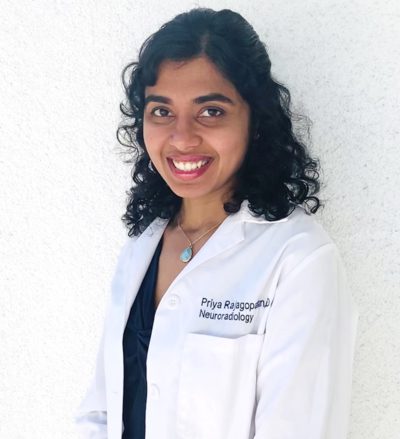By Sidney Taiko Sheehan
The Keck School of Medicine of USC’s Mark and Mary Stevens Neuroimaging and Informatics Institute (USC INI) is home to the Center for Image Acquisition (CIA), which provides high-resolution high-field imaging capabilities for both neuroscientific research and clinical applications. Opened in 2016, the CIA is an MRI facility housing a Siemens Magnetom Prisma, a 3 Tesla MRI scanner, and a Siemens Magnetom 7T MRI scanner. These scanners include unparalleled innovations for neuroimaging.

Priya Rajagopalan, MBBS, MPH, of the Center for Image Acquisition at the USC Mark and Mary Stevens Neuroimaging and Informatics Institute. (Photo USC/INI
“The CIA combines two of the world’s most advanced MRI scanners with dedicated supercomputing systems, cutting-edge analysis techniques, and expertise to image, map, and model the structure and function of the living human brain with unprecedented detail,” says USC INI Director Arthur W. Toga, PhD. “It is with immense pleasure that I announce the appointment of Priya Rajagopalan as the CIA’s new medical director.”
For Assistant Professor of Clinical Radiology, Priya Rajagopalan, MBBS, MPH, her new role is like a homecoming. Early in her academic career, she served as a research associate for the Laboratory of Neuro Imaging (LONI), which was launched by Toga in 1983 and became a part of the INI in 2013. “It’s truly meaningful to have researchers join us early on, go elsewhere to hone their skills, and then return in some new capacity. It reinforces our culture here at the INI and shows the strength and diversity of our work,” says Toga.
“From early on during medical school, I knew I wanted to study the brain and I considered neurology,” says Rajagopalan. “It was during my time at LONI that I started working on research projects and became fascinated with neuroimaging. INI Associate Director Paul M. Thompson was my mentor at the time and his encouragement and enthusiasm inspired me to take the path that led me here today.”
As medical director, Rajagopalan will oversee all clinical scans performed at the CIA. She will coordinate with clinical researchers on various imaging projects, while ensuring any scans from research participants that may show the need for acute medical intervention, are effectively managed.
“The CIA houses specialized tools and equipment enabling a variety of imaging techniques to be employed for interdisciplinary research,” notes Rajagopalan. “Though research has been the primary focus, we’re excited to expand further into the clinical realm.”
Rajagopalan also serves as the assistant program director for neuroradiology fellowships at the Keck School. She collaborates closely with residents and fellows across USC and is enthusiastic about mentoring others to help them find their calling. “I see my new role at the CIA as another opportunity to get the next generation interested in neuroimaging. With these fantastic resources at our fingertips, the CIA is becoming a hub for experiential learning, research, and clinical investigation.”
For more information about how you can use the Siemens Magnetom Prisma, the 3 Tesla MRI scanner, or the Siemens Magnetom 7T MRI scanner for your own research, please contact Sidney Taiko Sheehan at ssheehan@ini.usc.edu.